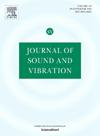Measurement, scaling and optimal dimensions of airfoil leading-edge serrations in isotropic turbulence
IF 4.3
2区 工程技术
Q1 ACOUSTICS
引用次数: 0
Abstract
Noise reduction results are presented for a set of leading edge serrations on a flat plate airfoil in isotropic turbulence, obtained from integrated beamforming results. Triangular, sinusoidal, and tangent serration profiles have been investigated, as well as a modified sinusoid which consists of a sinusoid at the tip and a tangent curve at the root. The serrations have a non-dimensional amplitude and wavelength of and between 0.7 and 15 respectively, where is the serration amplitude, is the chord length, is the serration wavelength and is the spanwise integral length scale of the incoming flow. All serrations show a reduction in noise level compared to the straight leading edge reference case. Between 2 and noise reduction was observed for all cases at a Strouhal number based on , , with value 0.1. Above , leading edge noise reduction increases with frequency and peaks at a serration wavelength of , a trend that holds for all shape profiles investigated. In this higher frequency range, subtle variations in shape profile significantly vary the noise reduction qualities. The modified sinusoidal profile outperforms all others up to , as long as the serration wavelength is shorter than . At higher frequencies, the modified sinusoidal serrations have a similar noise reduction to the triangular and tangent curve serrations, which reaches a maximum of for serrations with . Overall sound pressure level results show the noise reduction in this high-frequency regime is independent of the Reynolds number. Fluctuating pressure measurements at the roots of the sinusoidal serration are used to extend previously published models of the optimal serration wavelength. For the current data set, the optimal serration wavelength approaches at high Reynolds numbers. Furthermore, a reinterpretation of historical data, combined with the present data set, shows the optimal serration wavelength depends upon the ratio of serration amplitude to streamwise turbulent length scale .
各向同性湍流中翼型前缘锯齿的测量、缩放和最佳尺寸
本文介绍了各向同性湍流中平板翼面前缘锯齿的降噪结果,这些锯齿是通过综合波束成形结果获得的。研究了三角形、正弦曲线和正切锯齿剖面,以及修正的正弦曲线,其中正弦曲线位于顶端,正切曲线位于根部。锯齿的非尺寸振幅和波长分别为 h/c=0.065 和 λ/Λt 0.7 至 15,其中 h 为锯齿振幅,c 为弦长,λ 为锯齿波长,Λt 为流入气流的跨度积分长度尺度。与直前缘参考情况相比,所有锯齿都能降低噪声水平。当基于 h 的斯特劳哈尔数 Sth 值为 0.1 时,所有情况下的噪声都降低了 2 到 3 分贝。当 Sth=0.3 以上时,前缘噪声降低随频率增加而增加,在锯齿波长为 λ/Λt=1 时达到峰值,这一趋势对所有调查的形状轮廓都适用。在这一较高频率范围内,形状轮廓的细微变化会显著改变降噪质量。只要锯齿波长短于 λ/Λt=4,修改后的正弦轮廓在 Sth=1 以下都优于所有其他轮廓。在较高频率下,改进型正弦锯齿的降噪效果与三角形和正切曲线锯齿相似,λ/Λt=4 的锯齿最大降噪效果为 9dB。总体声压级结果表明,这种高频情况下的降噪效果与雷诺数无关。正弦锯齿根部的波动压力测量结果被用于扩展之前公布的最佳锯齿波长模型。对于当前的数据集,在高雷诺数时,最佳锯齿波长接近 λ/Λt=2.7。此外,结合当前数据集对历史数据的重新解释表明,最佳锯齿波长取决于锯齿振幅与流向湍流长度尺度 h/Λx 的比率。
本文章由计算机程序翻译,如有差异,请以英文原文为准。
求助全文
约1分钟内获得全文
求助全文
来源期刊

Journal of Sound and Vibration
工程技术-工程:机械
CiteScore
9.10
自引率
10.60%
发文量
551
审稿时长
69 days
期刊介绍:
The Journal of Sound and Vibration (JSV) is an independent journal devoted to the prompt publication of original papers, both theoretical and experimental, that provide new information on any aspect of sound or vibration. There is an emphasis on fundamental work that has potential for practical application.
JSV was founded and operates on the premise that the subject of sound and vibration requires a journal that publishes papers of a high technical standard across the various subdisciplines, thus facilitating awareness of techniques and discoveries in one area that may be applicable in others.
 求助内容:
求助内容: 应助结果提醒方式:
应助结果提醒方式:


